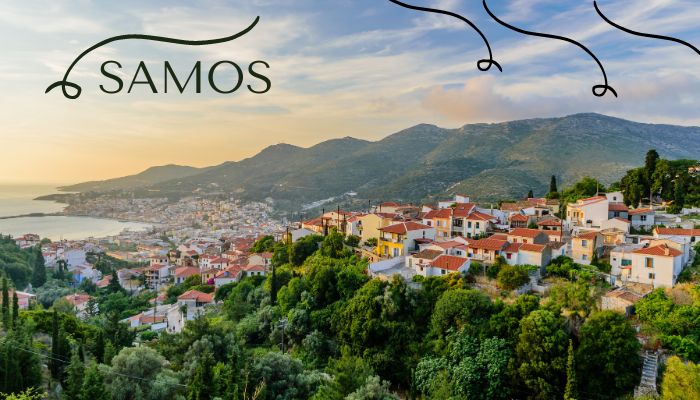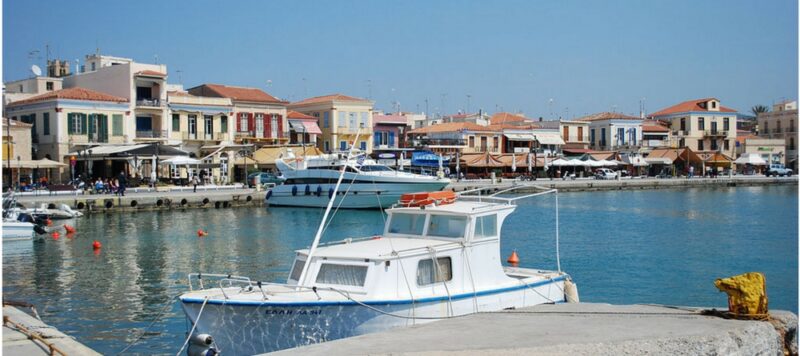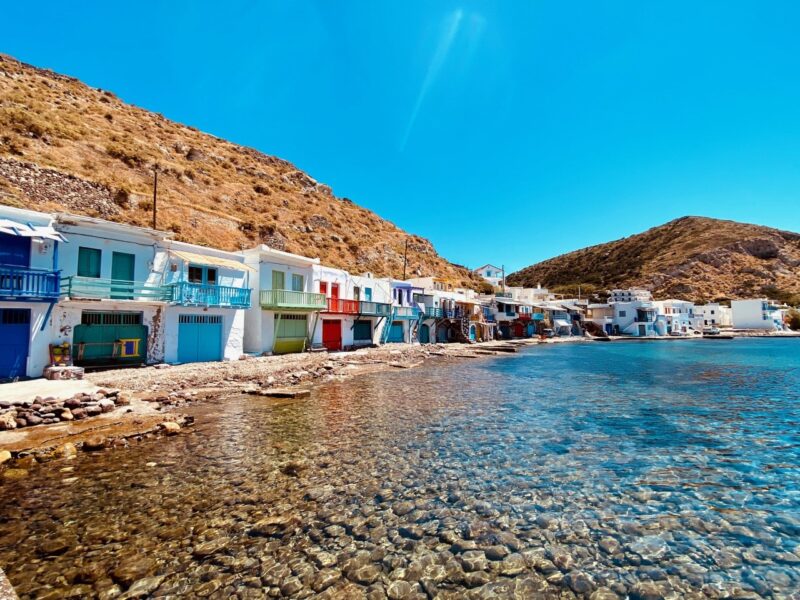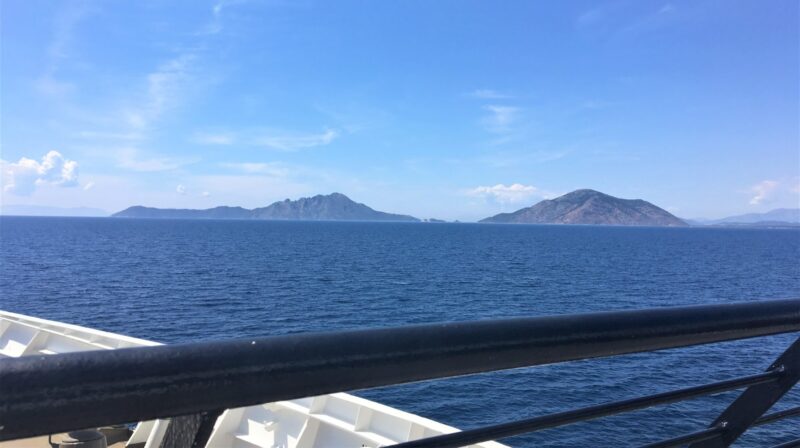Samos is a large Greek island in the North Aegean Sea with an area of 476 km 2. It is located between Ikaria and Turkey, with which it is separated by just 1.6 km by the Mycale Strait. With its many pebble and sandy beaches, beautiful landscapes, green mountains for hiking, cool mountain villages, fishing villages and tavernas, and above all great archaeological sites, there’s something for everyone! Birthplace of the goddess Hera, the mathematician Pythagoras and the philosopher Epicurus, many of the ancient remains of Samos are listed on the UNESCO World Heritage Site. This green and peaceful mountainous island is not overly touristy, but authentic. Planning a trip to Samos and wondering what to see and do on the island? Here we go with our Top 10 must-sees and best things to do in Samos!
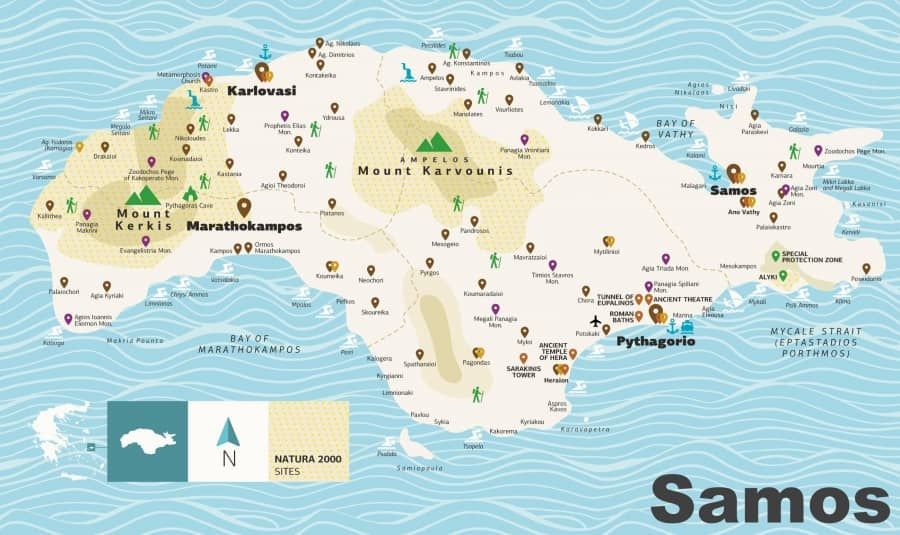
- 1 – Walk through Kokkari
- 2 – Choose your favorite beach on Samos
- 3 – Visit the Samos Heraion, the temple dedicated to Hera
- 4 – Strolling through Pythagoreio
- 5 – Going down the Eupalinos tunnel
- 6 – Explore the narrow streets of mountain villages like Manolates
- 7 – Enjoy the charm of fishing villages
- 8 – Visit the island’s capital, Vathy
- 9 – A breath of fresh air: hiking and water sports
- 10 – Taste the local produce and culinary specialties of Samos
To complete your overview of Samos, after reading this article, take a look at our Samos travel guide to find out how to get to Samos? getting around the island, when to go, where to stay? and where to eat?
1 – Walk through Kokkari
This small port town is one of the must-sees in Samos. In the heart of the village, you’ll find a number of boutiques in small pedestrian lanes, surrounded by brick-roofed houses. In the bay, cosy tavernas and cafes line the pedestrian quayside. As close as possible to the sea and in a peaceful setting, this is my favorite place to relax and let time pass while admiring the view. Or continue the stroll to the end of the harbor to the small Moshonisi hill to see the stag sculpture (Ελάφι). For a swim, head for the large pebble beach at Kokkari, where you’ll also find numerous cafes and traditional tavernas offering deckchairs and umbrellas. Kokkari, a charming little village well worth a stop. One of my favourites things to do in Samos!
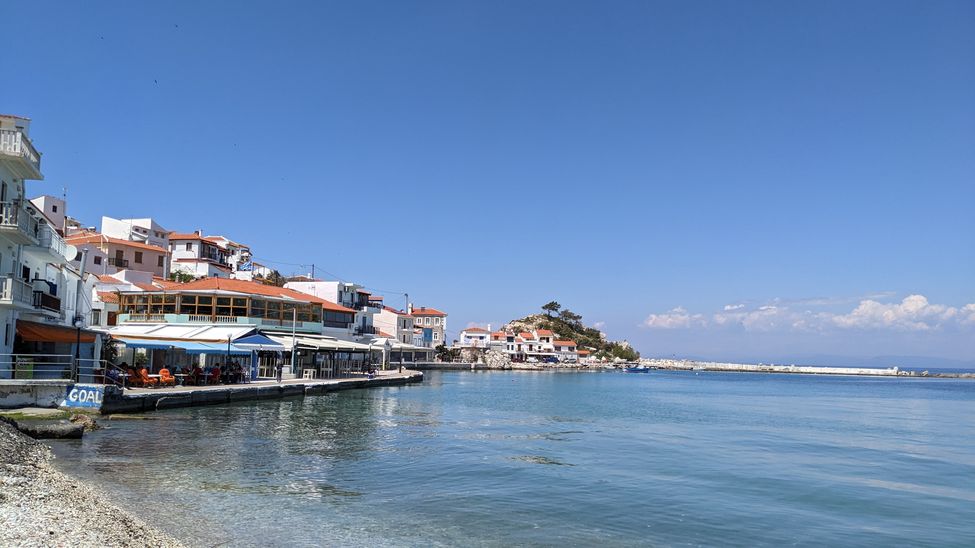
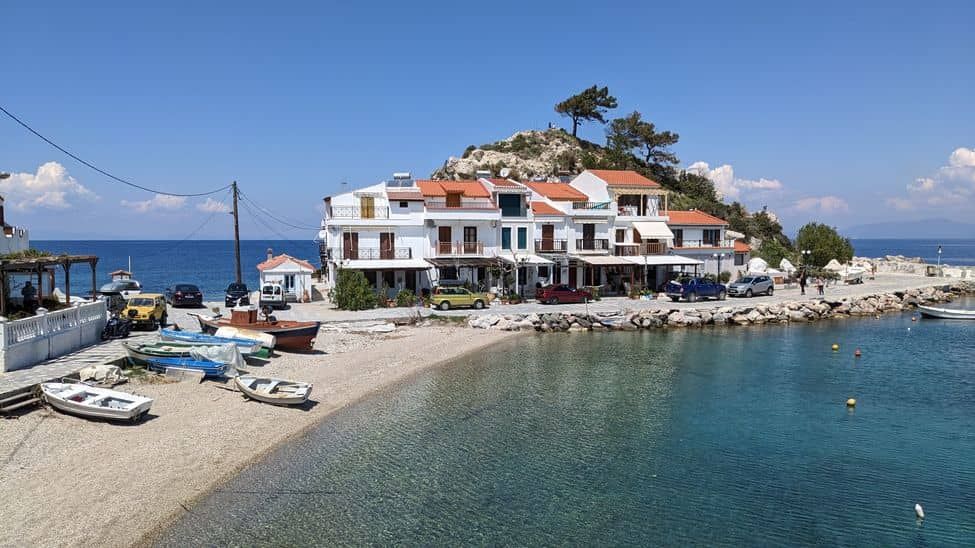
2 – Choose your favorite beach on Samos
Samos also has many beautiful beaches. To the north, these are pebble beaches (of varying sizes), exposed to the wind when the Meltemi blows. There are beautiful stretches of sand to the south of the island, as well as other pebble beaches.
North coast
For these mostly pebble beaches, don’t forget your sea shoes.
Livadakia Beach: Located at the very eastern end of the island of Samos, Livadakia Beach is a magnificent bay beach. To get there, you have to drive the last 2-3 kilometers on a wide dirt road with numerous potholes. But it’s worth the effort. The beach is equipped with beach bar, umbrellas and deckchairs. There’s even a swing in the sea! It’s a family-friendly beach because the sea is shallow for several meters. It can, however, be quite turbulent, depending on the winds. Very busy in summer, so if you’re looking for peace and quiet, go early in the morning.
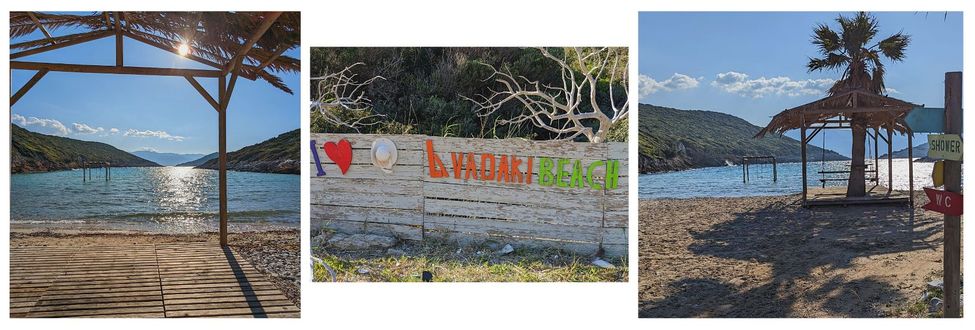
Tsamadou Beach: A large, beautiful pebble beach with turquoise waters on the island’s north coast between Agios Konstantinos and Kokkari. There’s an area with deckchairs, umbrellas and a beach bar, as well as space for towels. For families with children in particular, the area on the right is a nudist zone.
Potami Beach: Continuing westwards, near Karlovasi, Paralia Potami is another large pebble beach with an original shape. Cafes and tavernas have set up deckchairs and umbrellas (free with drinks), but you can also enjoy the undeveloped area. Beware, the beach is very exposed to northerly winds. Nearby, waterfalls cascade into the sea, refreshing it at the same time. Superb views of the beach from the Agios Nikolaos chapel.

South coast
Psili Ammos (or Chryssi Ammos) beach: On the south coast facing Turkey, Psili Ammos, as its name suggests, is a fine sandy beach with translucent waters. Renowned for having few sandy beaches on Samos, it is ideal for children as it is shallow. Partly landscaped, with cafes and restaurants along the beach.
Mykali Beach, just off Psili Ammos, this large pebble beach is particularly suited to water sports. A word of advice: take a seat at the Kalypso tavern, where you’ll enjoy a delicious meal, plus the tavern’s deckchairs and umbrellas.
There are also other lovely beaches to the south, such as Potokaki near Pythagoreio, Votsalakia (Kampos) and Limnionas to the south-west; to the north, Lemonakia and Tsambou; and further east, Mourtia, Kerveli, Platanaki and Posidonio. In short, you’re spoilt for choice! Find out more on the Greek website Visit Samos.
3 – Visit the Samos Heraion, the temple dedicated to Hera
The Herion, also known as the temple of Hera, stands as a must-see attraction, one thing to do on the island of Samos. Dedicated to Hera, the wife of Zeus and a native of Samos, this UNESCO World Heritage Site is a significant archaeological marvel. Located 6 km west of Pythagoreio, the ancient port city, the Herion hosted several temples dedicated to the goddess between the 8th and 5th centuries BC.
Upon entry, a QR Code facilitates the download of a comprehensive PDF providing explanations about the archaeological site, complemented by explanatory panels along the way.
Begin your exploration on the Sacred Way leading to the Heraion. The remains of the renowned 5th-century BC temple include a column, only half its original height, hinting at the immense size of the structure, supported by 155 columns. In its prime, the temple measured 108m in length and 55m in width, making it one of Greece’s largest temples.
Towards the far end of the site, a building on the left houses various fragments unearthed on the premises. As you head back towards the entrance, Roman brick pipes’ remnants and a beautiful mosaic come into view.
Practical info: Full Price 6€, Reduced 3€, free for children
Generally open from 8:30 a.m. to 3:30 p.m., the site is closed on Tuesdays. Find out more on the official Odysseus Culture website.
Although appreciating the historical significance with the remaining stones might be challenging, a visit to the Heraion, a UNESCO-listed archaeological site, is highly recommended. To delve deeper into the ancient world, extend your exploration to the Vathy Archaeological Museum, showcasing various finds from the Heraion, including an impressive 5-meter-high Kouros.
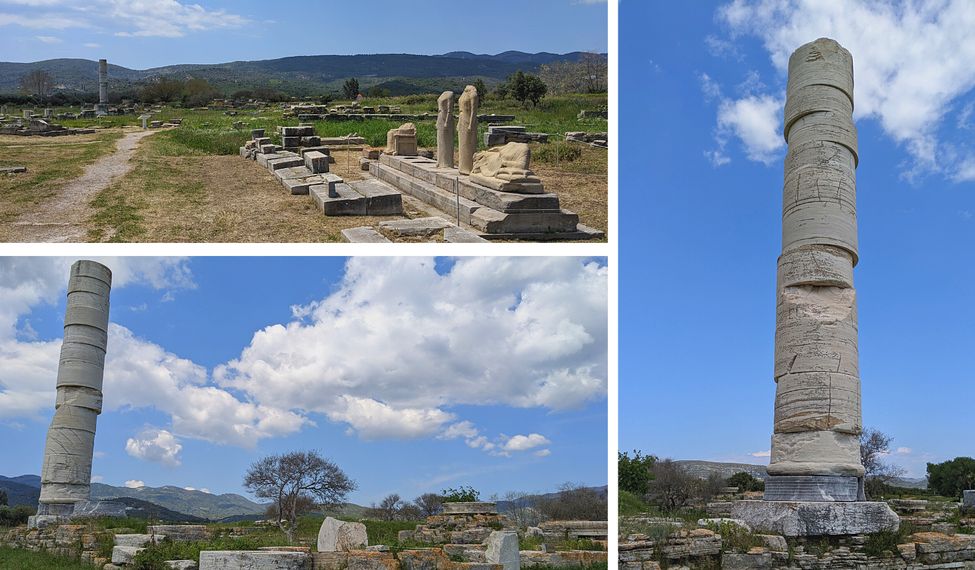
4 – Strolling through Pythagoreio
Pythagoreio is a pretty port town that I loved visiting. The many taverns and cafes lining the harbor invite you to stop by. Steeped in history, Pythagoreion was the great fortified port city of Samos in the 5th century BC. In fact, it is a UNESCO World Heritage Site, thanks to the numerous remains located nearby. But it’s also the birthplace of the famous Pythagoras, as evidenced by the large statue on the harbour.
So here’s a selection of points of interest to see and do in Pythagorieo, Samos:
- The port, its terraces and the statue of Pythagoras,
- Castle of Lykourgos Logothetis, leader of the resistance during the War of Independence of 1821
- The picturesque Blue Street, taken over by artists, gives you the opportunity to get lost in the city’s cobbled streets and take some great photos.
- The archaeological museum and its remains found in Pythagoreion and the Heraion,
- The archaeological site of the Roman baths (to be admired from the road),
- The ruins of Polycrates’ wall,
- Panagia Spiliani monastery. A superb panorama of the island and a stunning location. In the cool of a large grotto, don’t miss the small 17th-century chapel housing an icon of the Virgin Mary carved into the rock. If you’d like to find out more about its history: Samos In.
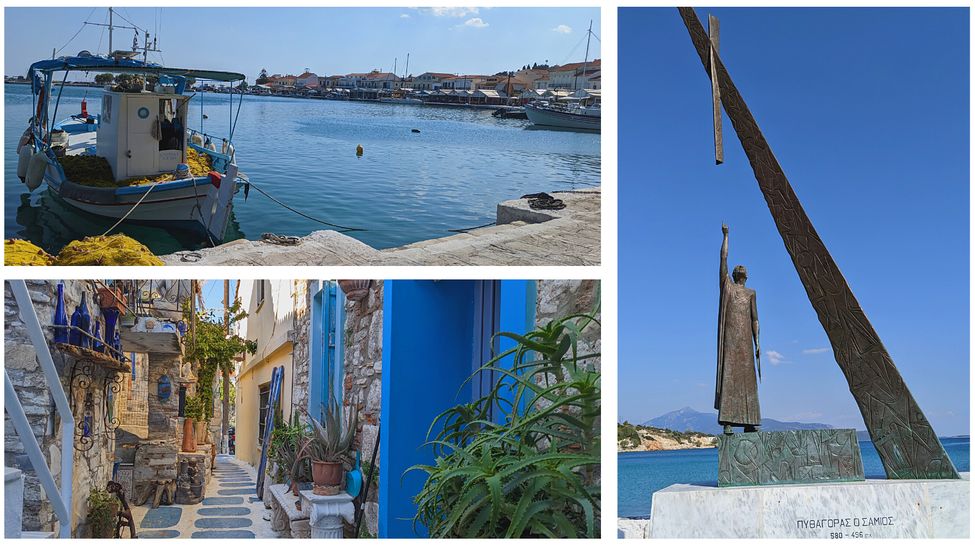
Not forgetting, of course, the 2 major UNESCO World Heritage sites: the Eupalinos tunnel and the Herion, the temple of Hera. Two must-see sites to do on Samos.
5 – Going down the Eupalinos tunnel
A Unesco World Heritage site, the Eupalinos Tunnel (named after its engineer) is an underground aqueduct dug into the mountain in the 6th century BC. It’s one of the greatest engineering feats of antiquity. In fact, work began from 2 opposite entrances. Digging simultaneously, the 2 teams met in the middle of the mountain, thanks to Eupalinos’ clever calculations. At the time, the aqueduct was 1,036 metres long and supplied water to the city of Pythagoreion. Later, the tunnel served as a refuge for the inhabitants of Samos in the event of invasion.
Practicalities: Please note that only those over 14 years of age may visit the site. Open from 8:30 a.m. to 3:30 p.m. Closed on Tuesdays. 2 possible itineraries, Route 1 at €8 – approx. 185 m – 20 mins; and Route 2 at €10 – approx. 500 m – 40 mins to reach the meeting point of the 2 teams digging the tunnel. Accompanied but unguided tour not recommended for claustrophobic visitors. Find out more on the official Odysseus Culture website.
6 – Explore the narrow streets of mountain villages like Manolates
Manolates is a picturesque mountain village built on the slopes of Mount Ampelos in the north of the island. Once you’ve reached the village, park in the small parking lot at the entrance, as Manolates can be visited on foot. Admire the unobstructed view of the Aegean Sea. As you stroll through the narrow cobbled streets of this traditional village, you’ll discover old stone houses, a small museum, ceramics and jewelry stores… A charming, authentic mountain village where it’s very pleasant to stroll around or stop to cool off. The two small squares in the middle of the pedestrian streets are perfect for lunch or a coffee on the terrace.
Manolates is also the starting point for several signposted hiking trails. A map of the village at the entrance lists the various paths leading from the village.

Other picturesque villages in the mountains were recommended to us but we didn’t have the chance to discover them: Vourliotes, Ampelos and Platanos.
7 – Enjoy the charm of fishing villages
Here are just a few of the pretty seaside villages worth a visit:
Posidonio, in the very south-east of Samos, faces Turkey. This small fishing village has remained authentic. A calm atmosphere, a port where a few boats dock, traditional tavernas and a small pebble beach shaded by pine trees. From the port, climb the stairs through the houses to the church of Agios Nikolaos for a superb view of the Turkish coast. Here on the map.
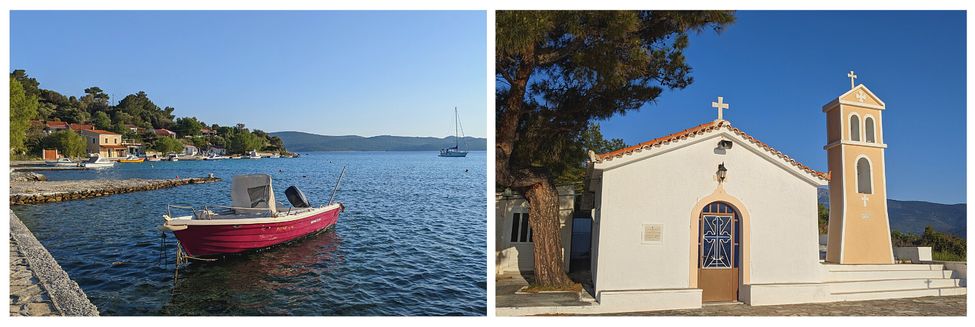
Agios Konstantinos, in the north of the island, is a pretty, picturesque seaside resort. Quiet, with a pebble beach. There are also several good taverns and cafés on the waterfront. On the map.
Avlakia is a small village between the road and the sea, but it’s worth taking a break. Agios Nikolaos is a charming little church on the water’s edge. There’s also a pebble beach and a very good taverna recommended by Katerina. On Google Maps.
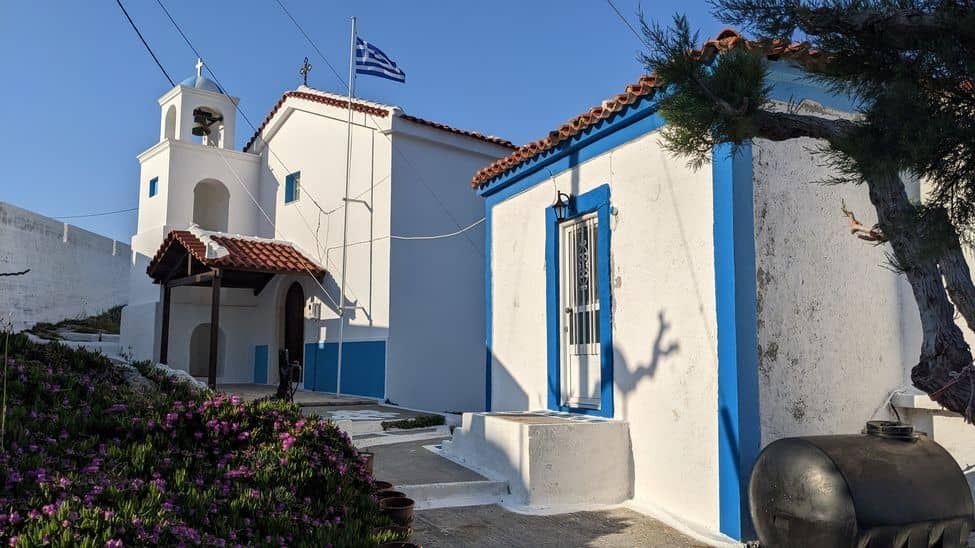
8 – Visit the island’s capital, Vathy
Vathy (also known as Samos) is the island’s capital and one of its main ports, along with Karlovasi. Personally, we didn’t find the lower town very interesting.
But here are some of the places to see and museum to do in Vathy (Samos):
Higher up, the old town of Samos, Ano Vathy, is built in the shape of an amphitheatre. Lose yourself in its narrow streets and discover beautiful houses with tiled roofs, fountains and churches.
The Samos Archaeological Museum houses a collection of ancient sculptures, including the gigantic 5-metre Kouros discovered at the Herion in 1980, the largest Kouros in Greece! More information on Odysseus Culture.
The Samos Wine Museum presents the history of Samos wine, from its cultivation on mountain terraces to its packaging. Wine tasting and purchase at the museum store. Samos Wine.
The Ecclesiastical and Byzantine Museum, a small museum located near the Port (Google Maps), exhibits icons, crucifixes, various religious objects and rare manuscripts.
9 – A breath of fresh air: hiking and water sports
On Samos, you’ll find few plains and 2 major mountain ranges: the rocky, rugged Kerkis (1443 m) and the greener Ampelos (1160 m). Caves, torrents, lush vegetation… Samos is a great playground for hikers! But lovers of the sea will also find plenty of activities and water sports to enjoy in the translucent blue waters.
Hiking and walking in Samos
Here are a few hikes to do in Samos.
- Hike from Votsalakia to Vigla summit, the highest point of Mount Kerkis. Quite difficult. The first part to the Evangelistrias monastery can be done by car. Then continue to the Profitis Ilias church before reaching the summit. A superb panorama guaranteed! More on AllTrails
- Hike from Potami beach to the Potami waterfalls. Wear a bathing suit and sea shoes. There are several cascades, including a 2-metre waterfall that plunges into a small lake for swimming. The 1st cascade is easy to access. The other 2 require a climb. Access from the Archontoula tavern is simpler. Not recommended for children or non-athletes. AllTrails.
- From Potami beach, hike to Mikro Seitani and Megalo Seitani beaches. Two beautiful, unspoilt beaches accessible only on foot through the forest. Provide plenty of water. AllTrails
- Hike from Marathokampos to Pythagoras’ cave, where the mathematician and his disciples lived in hiding. You can drive up to a small parking lot. There are 2 caves accessible by stairs, the first of which houses the Sarantadaskaliotisa chapel, then to reach the Pythagoras cave, you have to climb a 3-metre rock. Take a flashlight and suitable footwear. AllTrails
- Hike from Kallithea to the chapel in the Panagia Makrini cave. A dirt track leads from the village to the Agia Paraskevi chapel (which can also be reached by car). The last part is a steep climb on foot. Wear suitable footwear. Google Maps.
Activities and water sports in and around Samos
- With the Meltemi wind sweeping along the north coast, you can enjoy windsurfing, kite surfing and other board sports at Kokkari (Samos Windsurfing), Tsamadou or Agios Konstantinos. To the south, in Pythagorion, you’ll find a center for water skiing, surfing and windsurfing.
- Don’t miss this full-day boat trip to Samiopoula island and the south coast, with BBQ lunch included.
- You can also opt for a boat trip in complete freedom by renting a boat for a day or more, with or without a skipper.
- And why not treat yourself to an unforgettable vacation and book a one-week cruise on a sailing boat to discover the islands of the Northern Dodecanese.
10 – Taste the local produce and culinary specialties of Samos
Local products to pack in your suitcase
To prolong the taste of your vacation, here are a few ideas of products made in Samos to take home with you:
- The world-renowned white Muscat wine of Samos (Moschoudi), grown in traditional terraces on the slopes of Mount Ampelos.
- Samos ouzo from the Frantzeskos distillery. Aniseed and different kinds of local herbs are combined to give this specific taste.
- Souma, Samos raki made from grape marc
- Samos olive oil, an excellent quality oil with low acidity
- Pure, fragrant honey harvested mainly around Pyrgos
- but also goat’s and sheep’s cheese.
Tasty recipes
The cuisine of Samos, influenced by Asia Minor, consists mainly of local ingredients and many herbs. To be tasted as soon as possible:
- Revythokeftedes, chickpea dumplings
- Zucchini flowers fried or stuffed with rice
- Kampounia, fried onion sprouts with eggs
- Bourekia, pita topped with pumpkin and local cheese with cinnamon
- Gemistas, stuffed vegetables such as tomatoes, peppers, eggplants and onions
- Giaprakia, vine leaves from Muscat vineyards stuffed with rice
- Other specialities are cooked for special occasions: stuffed lamb for Easter, giorti made with boiled goat, keskek for New Year’s Eve…
- And to name but a few desserts: kserotigana, diples, katmaria, moustalevria, baklava, katades, tachinopita, starozoumo…
For even more information, visit the website Visit Samos.
Many thanks to Katerina and her cousin from Samos, for all the good advice and addresses ;). And even more information to help you plan your trip in our article Visiting Samos: travel guide.
Bonus: Myli and its thousand-year-old olive tree. Don’t make a big detour to go and see it, but if you’re in the area, it’s an opportunity to drive through the orange groves and discover a multi-centenary olive tree with a hollow trunk. It’s not well signposted, so first follow the Google Maps point: to the left of the ceramics store, take the small road between the houses. At the very end, turn right onto a dirt track and you’ll see the olive tree a little further along in a field on the right.
Article written by Virginie W.
